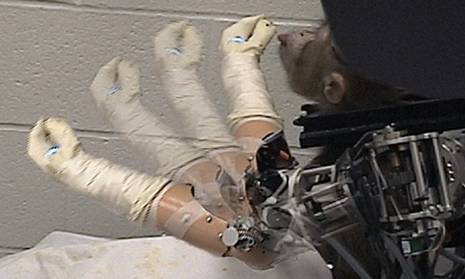
When our robotic overlords finally do take over, there's a decent chance they'll do it with monkey brains.
A few years back, Duke neuroscientists, funded by the Pentagon, figured out how to have monkeys control robotic arms with their little simian minds (above article). Now, if that wasn't unnerving enough, the same Duke crew has discovered a way for one of the monkeys to make "a 200-pound, 5-foot humanoid robot walk on a treadmill using only her brain activity," the New York Times reports. How far away are we from the ultimate sci-fi dystopia: Terminator and Planet of the Apes -- at the same time!
And did we mention that these same researchers recently took out a patent on mind-controlled weapons?
In preparing for the experiment, Idoya [the monkey] was trained to walk upright on a treadmill. She held onto a bar with her hands and got treats — raisins and Cheerios — as she walked at different speeds, forward and backward, for 15 minutes a day, 3 days a week, for 2 months.
Meanwhile, electrodes implanted in the so-called leg area of Idoya’s brain recorded the activity of 250 to 300 neurons that fired while she walked. Some neurons became active when her ankle, knee and hip joints moved. Others responded when her feet touched the ground. And some fired in anticipation of her movements.
To obtain a detailed model of Idoya’s leg movements, the researchers also painted her ankle, knee and hip joints with fluorescent stage makeup and, using a special high speed camera, captured her movements on video.
The video and brain cell activity were then combined and translated into a format that a computer could read. This format is able to predict with 90 percent accuracy all permutations of Idoya’s leg movements three to four seconds before the movement takes place.
On Thursday, an alert and ready-to-work Idoya stepped onto her treadmill and began walking at a steady pace with electrodes implanted in her brain. Her walking pattern and brain signals were collected, fed into the computer and transmitted over a high-speed Internet link to a robot in Kyoto, Japan.
Military scientists have tried all different combinations of animal and machine -- cyborg pigeons, radio-controlled rats, steerable shark spies. The Duke experiments are the "first steps toward a brain machine interface that might permit paralyzed people to walk by directing devices with their thoughts," according to the Times. Electrodes in the person’s brain would send signals to a device worn on the hip, like a cell phone or pager, that would relay those signals to a pair of braces, a kind of external skeleton, worn on the legs."
“When that person thinks about walking,” Duke's Dr. Miguel Nicolelis says, “walking happens.”
No lie. And all kinds of researchers and military departments are working on similar efforts, to move towards thought-controlled exoskeletons and prosthetics. Notice, too, the robot in this experiment was built by exoskeleton-maker Sarcos.
But that still doesn't mean we shouldn't panic.




